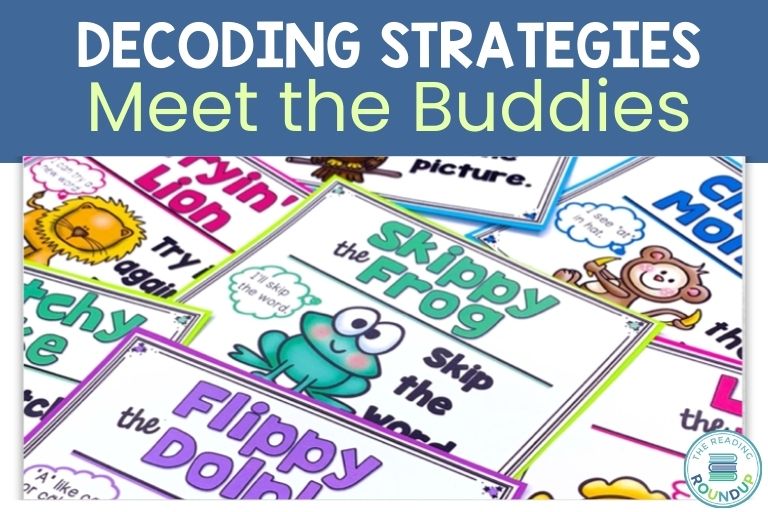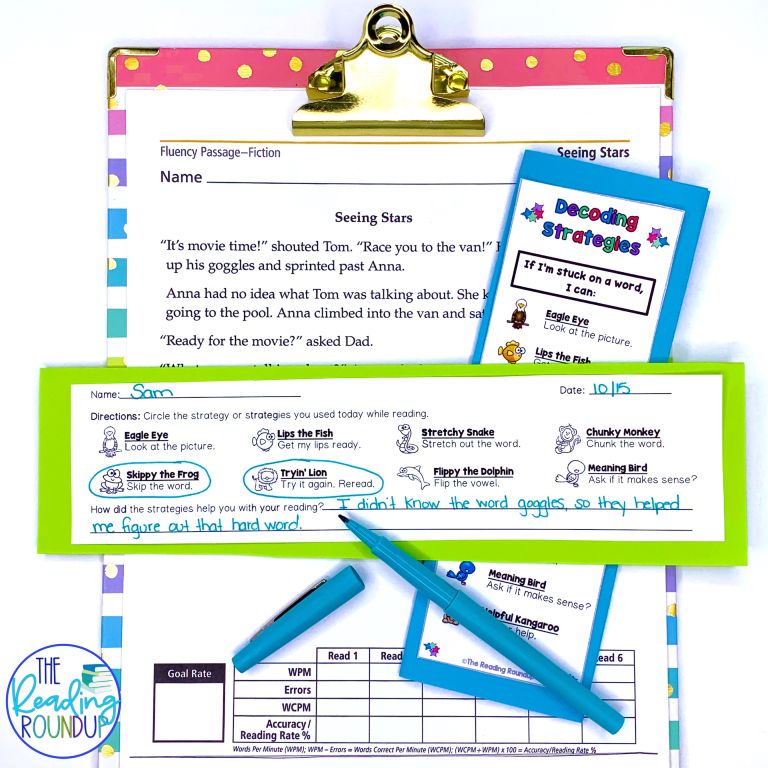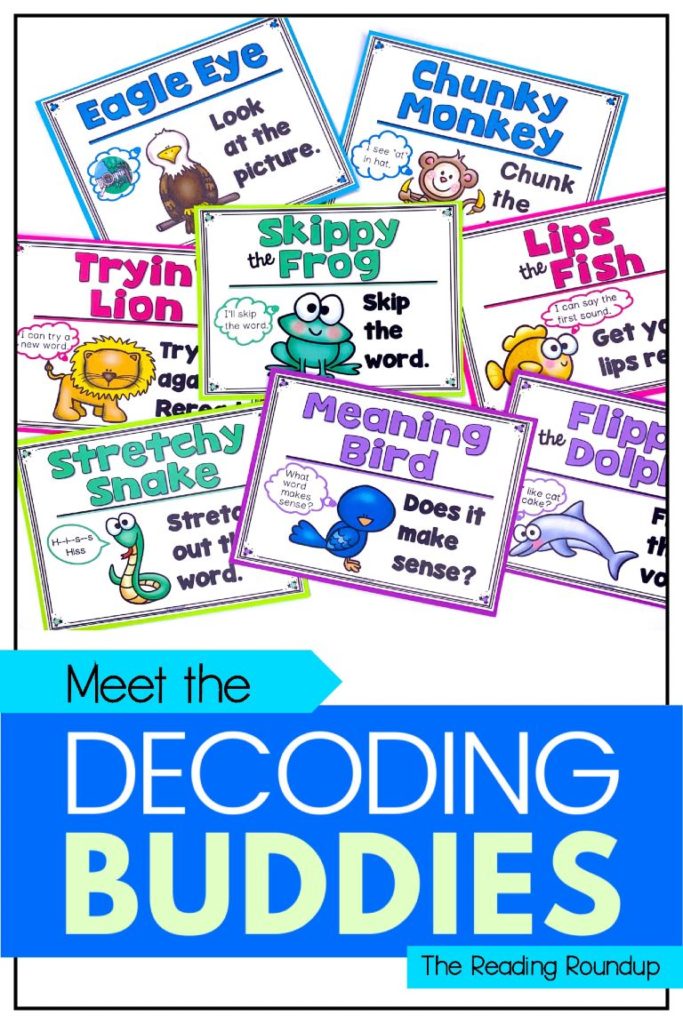
If I had to name the one teaching strategy that has been the most effective in helping my students with decoding, it would be the Beanie Babies Reading Strategies – without question! Because of these strategies, my students can verbally explain what to do when they’re stuck on a word and independently make attempts at decoding unknown words.
Maybe you’re already familiar with the Beanie Babies Reading Strategies or maybe you have no idea what I’m talking about. But hopefully by my sharing what has worked for me, you’ll find some new ideas to try in your guided reading lessons.
Be sure to check out Part 2 of this series to find out the steps for introducing these strategies with your students and part 3 to learn additional tips for implementation.
This post includes affiliate links for which I may make a small commission at no extra cost to you should you make a purchase.
Science of Reading Update
I have created new decoding strategies that are similar to the Beanie Baby Reading Strategies but are in alignment with the Science of Reading. These new decoding strategies encourage students to look at the word and apply phonics skills versus implementing guessing strategies such as looking at the picture to figure out a word. You might be interested in these new strategies as an alternative to the Beanie Babies!


The Beanie Babies Reading Strategies for Decoding
Before I tell you how I use the Beanie Babies decoding strategies, let me first introduce you to our friends! Below you’ll find a quick overview of the 9 decoding strategies.
Introducing the Beanie Baby Reading Strategies to Students
I introduce one strategy at a time to provide students with ample opportunities to practice the strategy. With Kindergarten and 1st grade, I typically introduce one strategy a week. I wait until students are able to begin independently implementing and explaining the strategy before moving on to the next one. This timing may vary depending on students’ needs. A strategy such as Eagle Eye typically does not require as much practice. With 2nd graders, I’m able to introduce a couple of strategies a week as it is just a review for them. Visit part 2 of this series to get a more in-depth look at the steps I use to introduce each strategy.
Eagle Eye

I always introduce Eagle Eye first. I explain to the students that he helps us by looking at the picture. We can use the clues in the picture to figure out the unknown word. He is the easiest one to start with since students naturally tend to look at the picture first anyway.
Lips the Fish
Another relatively easy strategy for students is Lips the Fish. He gets his lips ready for the first sound of the word. We practice by covering up the endings of words to use the initial sounds to figure out what the word might be. I also refer back to Eagle Eye if they aren’t able to decode the word with just the initial sound. This keeps the previously taught strategy fresh in their mind, and shows how the strategies can work together.

Stretchy the Snake

Stretchy Snake is one of their favorite strategies! He stretches out the word and helps them sound it out. We practice by stretching out the snake Beanie Baby as we sound out CVC words. I also provide each student with a slinky to practice sounding out the word. Adding this hands on element helps the students internalize the strategy. It is important to remind the students that they must blend the sounds together after stretching it out to determine the word (Say C-A-T: cat).
Meaning Bird
I always teach Meaning Bird next. In the past, I found that students would overly depend on Stretchy Snake. They sounded out words but when they blended the sounds it didn’t make sense. As a result, I made Meaning Bird to remind students to think about what word would make sense.

Chunky Monkey

Chunky Monkey is another student favorite! She helps looks for known “chunks” in the words. This can be smaller words within larger words (an is in can), blends/digraphs (sh is at the end of fish), or endings (-s, -ing, -ed). The book There’s an Ant in Anthony is a great tool to help with this skill.
The students will quickly notice that these chunks don’t always help them decode the unknown word. (Example: They may notice so and me in some but that does not help them read the word). These irregular words are a great opportunity to teach students how the strategies can work together since they also need to think about what word would make sense.
Skippy the Frog & Tryin’ Lion
I typically teach Skippy the Frog and Tryin’ Lion together. Skippy the Frog skips an unknown word, while Tryin’ Lion encourages students to reread and try a word that makes sense and looks right. I tell students that these are buddies that like to work together. We talk about how we can’t skip a word forever because then our story will not make sense. They must go back to reread and try a word that would make sense or looks phonetically correct.
Flippy the Dolphin
The last strategy I introduce is Flippy the Dolphin as it requires students to have a knowledge of short and long vowel sounds. Flippy the Dolphin flips the vowel sound. If the word is “pot” we would sound it out with the short vowel sound p-o-t and the long vowel sound p-o-t-e. Then we talk about which word would make sense in the sentence. When we flip the vowel sound, we literally flip the dolphin Beanie Baby as a hands-on approach to make the strategy more concrete to the students.

Helpful Kangaroo
The final Beanie Baby Strategy is Helpful Kangaroo, which teaches students to ask for help. I honestly never introduce this strategy to my students because I want them to independently implement the other strategies and not rely on me to help them with the word.
Putting It All Together
As I introduce each strategy, I display the posters for students to refer to during guided reading. I also initially keep the actual Beanie Baby stuffed animals on the table for students to physically grab when they’re stuck on a word. Through continued modeling and authentic practice, students begin to individually implement multiple strategies while reading.

Our daily exit ticket is having students discuss which strategies they used and how they helped them decode an unknown word. It is extremely important to have students explain how they applied the strategies and not just state the name.
For example, students may say “I saw sh and out and blended them together to make the word shout” instead of just saying “I used Chunky Monkey.”
Continue reading to find out the steps for introducing these strategies with your students and additional tips for implementation.

Have you used these decoding strategies with your students or is there something else you’ve found to be more beneficial? Share your tips in the comments below!

Want to Pin this for later?
















Hi there. I’m just wondering if it was you who originally came up with the names/images of the Reading Strategies. I remember seeing them in 2009 when I was in my practicum but I can’t remember who created this first. The reason I am asking this is because I would like to use the strategies for some infographics but I’m not sure who to contact in order to get permission to do so. Thanks!
I am not the original creator. They were extremely popular when I began teaching and everyone was using them. Unfortunately, I don’t know who is the original creator of them. Sorry!